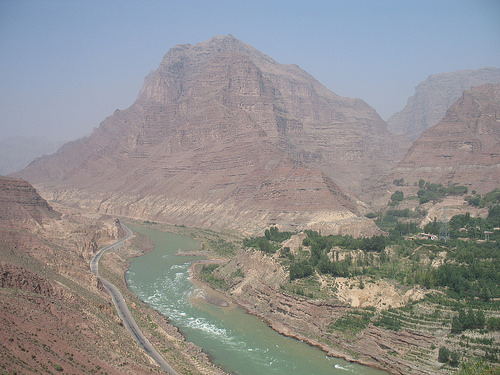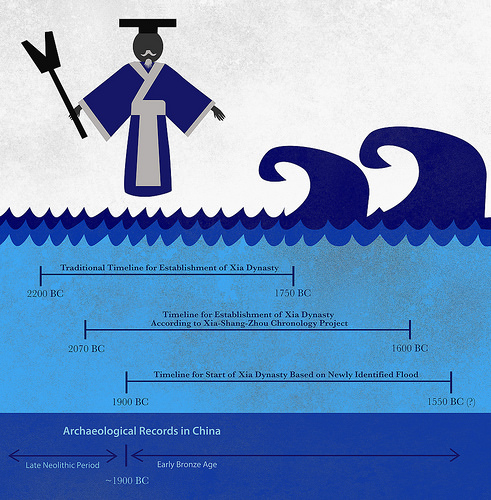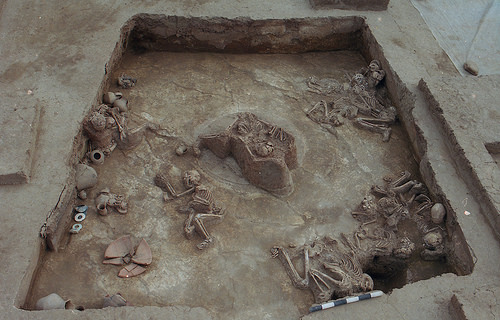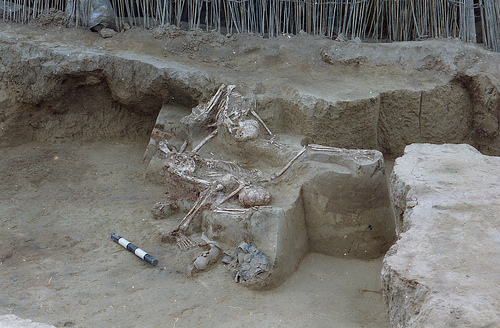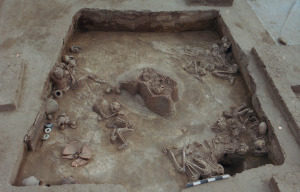
Researchers have provided geological evidence for China’s “Great Flood,” a disastrous event on the Yellow River from which the Xia dynasty is thought to have been born. The flood occurred in roughly 1920 BC, they say, which is several centuries later than traditionally thought – meaning the Xia dynasty, and its renowned Emperor Yu, likely had a later start than Chinese historians have thought, too. According to Chinese legend, Emperor Yu gained notoriety through his handling of the country’s Great Flood. By dredging the destructive floodwaters, he tamed them, “earning him the divine mandate to establish the Xia dynasty … and marking the beginning of Chinese civilization,” Wu Qinglong and colleagues write. Yu’s story was handed down for a millennium before entering the historical record, yet, geological evidence for the flood he mastered has always been lacking. Thus, “some scholars have argued that the story is either a historicized version of an older myth,” David Montgomery explains in a related Perspective, “or propaganda to justify the centralized power of imperial rule.”
Here, by reconstructing a sequence of events along the Yellow River – including a landslide that created a dam from which water built up and burst forth – Wu Qinglong and colleagues provide geological evidence for a catastrophic flood event that may be the basis of the Great Flood. The researchers mapped and dated distinctive sediments that were deposited downstream of a Qinghai Province dam when the dam broke. In further work, they determined that the flood that broke the dam was of enormous proportions. Using radiocarbon dating techniques on samples that included human bone, they dated the flood to 1920 BC. “The … flood shares the main characteristics of the Great Flood described in ancient texts,” the authors say. If their flood is indeed the event that came to be known as the Great Flood, researchers could propose a new start date for the Xia dynasty, at 1900 BC. This date not only coincides with the major transition from the Neolithic to the Bronze Age in the Yellow River valley, possibly resolving a longstanding contradiction among Chinese historians about when Xia started in relation to this critical period in history, but it also coincides with the beginning of the Erlitou culture that dominated China in the early Bronze Age – supporting arguments that this culture is the archaeological remains of the Xia dynasty. Taken together, these results reveal how the concurrence of these major natural and sociopolitical events may be an “illustration of a profound and complicated cultural response to an extreme natural disaster that connected many groups living along the Yellow River.
_________________________________________
Jishi Gorge upstream the landslide dam. The grey silt deposits dozens of meters above the water level are lacustrine sediments. Credit: Wu Qinglong
___________________________________________________________
The variable timelines for the start of the Xia dynasty according to traditional Chinese culture, the Xia-Shang-Zhou Chronology Project and the flood that was newly identified and dated by Wu, et al. Credit: Carla Schaffer/AAAS
_________________________________________________________
Fourteen skeletons of victims in Cave dwelling F4 at Lajia site excavated in 2000. Credit: Cai Linhai
____________________________________________
A view of the skeletons in cave F10 from another direction at Lajia site. Credit: Cai Linhai
_____________________________________________
This research* appears in the 5 August 2016 issue of Science. Science is published by AAAS, the nonprofit science society.
Source: American Association for the Advancement of Science news release.
______________________________________________________
*“Outburst flood at 1920 BCE supports historicity of China’s Great Flood and the Xia dynasty,” by Q. Wu; X. Wu at Peking University in Beijing, China; Q. Wu; Z. Zhao; S. Bai at Nanjing Normal University in Nanjing, China; Q. Wu; P. Zhang; D. Yuan at China Earthquake Administration in Beijing,China; L. Liu at Stanford University in Stanford, CA; D.E. Granger at Purdue University in West Lafayette, IN; H. Wang; M. Ye; W. Qi at Chinese Academy of Social Sciences in Beijing, China; D.J. Cohen at National Taiwan University in Taipei, Taiwan; O. Bar-Yosef at Harvard University in Cambridge, MA; B. Lu at CCTEG Xian Research Institute in Xi’an, China; J. Zhang at Chinese Academy of Geological Sciences in Beijing, China; L. Cai at Qinghai Provincial Institute of Cultural Relics and Archaeology in Xining, China; Z. Zhao; S. Bai at Jiangsu Center for Collaborative Innovation in Geographic Information Resource Development and Application in Nanjing, Jiangsu,China; P. Zhang at Sun Yat-sen University in Guangzhou, China.
______________________________________________________

______________________________________________
Travel and learn with Far Horizons.
____________________________________________
This richly illustrated issue includes the following stories: Recent findings shedding new light on the whereabouts of the remains of Philip of Macedon, father of Alexander the Great; how an archaeologist-sculptor is bringing bones of the dead back to life; archaeologists uncovering town life at the dawn of civilization; an exclusive interview with internationally acclaimed archaeologist James M. Adovasio about what makes the Meadowcroft Rockshelter prominent in the ongoing search for the first Americans; what archaeologists are finding at the site of the ancient city of Gath, the home town of the biblical Philistine giant, Goliath; and how scientists are redrawing the picture of human evolution in Europe. Find it on Amazon.com.

